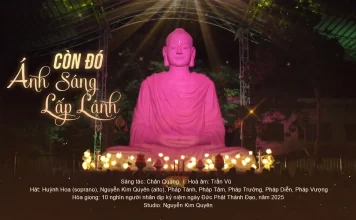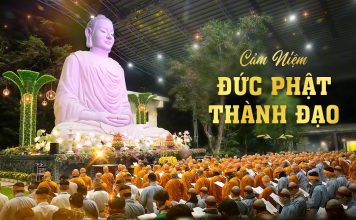THIỀN 28 MEDITATION 28
GỐC VÀ NGỌN – ROOT AND TOP

Ta đều hiểu rằng thiền định là phương pháp giúp tâm yên tĩnh, bớt suy nghĩ vẩn vơ, tiến đến dừng suy nghĩ hoàn toàn, tiến đến xóa sạch bản ngã vô minh sâu kín để hoàn thành sự nghiệp giải thoát giác ngộ như Phật đã dạy. Dĩ nhiên con đường giác ngộ này không phải đi trong vài ba kiếp mà hết được, có khi ta phải trải qua cả vài trăm vài nghìn kiếp mới hoàn thành.
Ở bước đầu, thiền giúp tâm ta bớt suy nghĩ vẩn vơ đã là cực kỳ lợi ích cho sức khỏe và chất lượng cuộc sống. Khi không bị các vọng tưởng vẩn vơ quấy rối, làm việc gì ta cũng có sự tập trung cao độ hơn. Không phải muốn tập trung là ta sẽ tập trung được ngay, mà phải có quá trình thiền định dẹp bỏ các suy nghĩ vẩn vơ trước đã.
Quá trình nhiếp tâm rất là phức tạp, nhiều công đoạn, nhiều phương pháp, đòi hỏi sự chính xác tỉ mỉ. Và đặc biệt là có gốc có ngọn rõ ràng. Ta phải dụng công sao cho luôn giữ vững cái gốc, đừng bỏ gốc theo ngọn, như thế công phu sẽ được ổn định.
– Khái niệm gốc ngọn thứ nhất là: Lòng tôn kính Phật là Gốc, mà Thánh quả giác ngộ là Ngọn. Nếu ai chỉ chăm chăm hướng đến thánh quả giác ngộ mà quên mất bồi dưỡng lòng tôn kính Phật đến vô hạn thì đó chính là bỏ gốc theo ngọn, sẽ không được kết quả gì. Hành giả phải vun đắp lòng tôn kính Phật sâu dày mãi, cho đến tuyệt đối, và chẳng cần quan tâm đến thánh quả giác ngộ. Vậy mà lúc nào đó, kiếp này hoặc kiếp khác, thánh quả sẽ đến. Vun đắp lòng tôn kính Phật có nhiều cách, cách đơn giản nhất là lễ kính Phật hàng ngày.
– Khái niệm gốc ngọn thứ hai là: Lòng từ bi yêu thương chúng sinh là Gốc, mà Trí tuệ tu hành là Ngọn. Trên đường tu hành, nội tâm ta diễn biến cực kỳ phức tạp, nhiều lỗi lầm kiết sử hiện ra cản trở đủ thứ, nếu không có trí tuệ để vượt thắng từng chút một thì ta sẽ nản lòng, thất bại, thậm chí bỏ cuộc. Nhưng nếu muốn có trí tuệ thì không phải chăm chăm suy nghĩ tìm cách này cách nọ, mà phải giữ cái gốc là bồi dưỡng lòng từ bi yêu thương chúng sinh vô hạn. Tâm ta phải tác ý mong cho chúng sinh đều tu hành giác ngộ. Khi ngồi thiền phải tác ý trải lòng yêu thương khắp nơi, yêu thương muôn loài.
– Khái niệm gốc ngọn thứ ba là: Tâm khiêm hạ kín đáo là Gốc, mà sự tiến bộ tâm linh là Ngọn. Không phải ta tu là tiến đâu, còn lệ thuộc tâm khiêm hạ của ta nữa. Nếu ta có khởi tâm tự hào bí mật, bộc lộ công phu, tự cho mình hay giỏi, thì càng tu càng thụt lùi, thậm chí có khi điên loạn luôn. Vì thế, đừng chăm chăm nôn nóng công phu thiền định phải tiến bộ đều đều, mà phải giữ kỹ cái gốc khiêm hạ, lúc nào cũng tôn trọng mọi người, lúc nào cũng xem mình là cỏ rác cát bụi mà thôi.
– Khái niệm gốc ngọn thứ tư là: Công đức làm lợi ích cho chúng sinh là Gốc, mà hoàn cảnh thuận lợi hay nội tâm dễ điều phục là Ngọn. Ta đừng tưởng mình thông minh giỏi giắn thì có thể khéo léo nhiếp tâm dễ dàng. Không, những kết quả đó do công đức mà thành, không phải do thông minh khéo léo. Ta càng vất vả phụng sự giúp đỡ giáo hóa thì tâm càng dễ nhiếp hơn.
Ai dại khờ chôn mình trong cô quạnh thì có khi chỉ cạn phước mà không được gì. Khi làm phước thì ta có vẻ bận tâm, nhưng bù lại sau đó tâm rất dễ nhiếp.
– Khái niệm gốc ngọn thứ năm là: An trú toàn thân làm vọng tưởng lắng dịu rồi tự mất đi. Khi an trú toàn thân, ta không cung cấp năng lượng cho vọng tưởng nữa. Còn khi để ý trên đầu, đối phó với vọng tưởng, không ngờ là cung cấp năng lượng cho vọng tưởng dấy khởi mãi. An trú toàn thân gồm có cả bụng và ngực là chính, sau này khắp thân đều biết rõ. Nếu biết sau lưng thì chỉ ở phần thắt lưng trở xuống mà thôi, cấm kỵ tập trung ở phần trên thắt lưng vì kích động vọng tưởng rất mạnh. An trú toàn thân là Gốc, mà vọng tưởng lắng dịu để vào định là Ngọn. Đừng bỏ Gốc theo Ngọn.
– Khái niệm gốc ngọn thứ sáu là: Hơi thở êm, chậm, ít là Gốc, mà cảm giác biết toàn thân là Ngọn. Nếu ta thở êm, chậm, ít, thì cảm giác tỉnh giác biết rõ toàn thân sẽ xuất hiện. An trú nơi cảm giác toàn thân đó thì vọng tưởng tự lắng dịu. Vọng tưởng lắng dịu, tâm tỉnh giác, cả trong khi ngồi thiền và trong đời sống hằng ngày, cho đến khi bất ngờ lọt vào Chánh niệm Tỉnh giác tự động hoàn toàn.
Ban đầu ta tập hơi thở căn bản là Biết mà không điều khiển, tập vài năm cho quen hơi thở. Quen thuần thục hơi thở tự nhiên rồi thì hãy ghìm hơi thở êm chậm ít lại để cảm giác toàn thân xuất hiện. Cảm giác toàn thân xuất hiện rồi thì vọng tưởng tự lắng dịu.
Khi tâm yên tĩnh, tâm sẽ có trạng thái trống rỗng sáng tỏ. Nhưng xin vui lòng làm ơn đừng an trú cái tâm đó, vì nó là ngọn. Xin vui lòng làm ơn vẫn an trú toàn thân thật kỹ, vẫn nhớ thân là vô thường tạm bợ, vẫn giữ hơi thở êm chậm ít rất kỹ. Khi tâm yên là khi tà kiến dễ xuất hiện. Ta sẽ tự đặt ra đủ thứ lý luận mới để tự đề cao mình, vô cùng nguy hiểm.
Tâm có yên gì thì cũng chưa vào được Chánh niệm Tỉnh giác. Mà có chứng nhập Chánh niệm Tỉnh giác thì cũng chưa phải đã hết vọng tưởng. Mà có hết vọng tưởng cũng chưa Nhập định. Mà có Nhập định cũng chưa chứng Vô ngã. Con đường còn dài lắm.
Sợ nhất là ta chiêm ngưỡng cái tâm yên tĩnh đó mà cho nó là Siêu Ngã, quay trở lại thời Tượng Pháp. Ta phải tìm về Vô Ngã của thời Chánh Pháp.
MEDITATION 28
ROOT AND TOP
We understand that meditation is a method of calming our mind, defusing wandering thoughts, and moving toward a stage of complete thoughtlessness. From this stage, the practitioner will then proceed to eliminate their ignorance and ego in order to accomplish the final goal of spiritual enlightenment as Buddha taught. Of course, the path of enlightenment can never be completed within several lifetimes. It takes hundreds or even thousands of lifetimes for a person to reach the end of this path.
First and foremost, meditation helps to reduce the amount of wandering thoughts in our mind. This is extremely beneficial for our health and our quality of life. Once our mind is less distracted by our wandering thoughts, we can become more focused and studious. It’s not easy to stay focused. We must meditate to get rid of the unwanted thoughts then we can increase attention span.
Concentrating our mind is a complex process which undergoes various stages, methods, and requires an extremely high level of accuracy. And especially, there must be a clear distinction between the roots (the foundation) and the crown (end goal). We have to apply meditative techniques in a way that the root always receives priority. To achieve a sustainable outcome, meditation practitioners should never pursue the crown and forget the roots.
The first distinction between the root and the crown is that the absolute respect toward Buddha is the root and the enlightened sainthood is the crown. Those who only focus on pursuing the enlightened sainthood and putting aside their absolute respect toward Buddha are forgetting the root and chasing the crown. These people will surely achieve no positive outcome in their spiritual cultivation.
Meditation practitioners have to cultivate the everlasting respect toward Buddha without caring about the enlightened sainthood. Once we give absolute respect to Buddha, anytime within this life or another, enlightened sainthood will come to us. There are many ways to cultivate our respect toward Buddha. The simplest method is to pay homage to Buddha every day.
The second distinction between the root and the crown is that having a compassionate heart with unconditional love is the root and the cultivated wisdom is the crown. On the path of cultivation, our inner world keeps changing in an extremely complex way. Numerous moral faults and hurdles will appear to hinder us in various ways. If practitioners don’t have sufficient wisdom to overcome every single obstacle, they will be demotivated and fail. That doesn’t mean that to have wisdom practitioners have to keep seeking various ways to get it but rather they should maintain the root, i.e., nourishing the boundless love to all beings. We have to remind ourselves of the wish that all beings will practice spiritual cultivation for achieving enlightenment. When practicing meditation, we have to deliberately spread unconditional love everywhere and to all beings.
The third distinction between the root and the crown is that modesty and non-disclosure are the roots and spiritual improvement is the crown. It is not accurate to say that as long as we practice cultivating there will be spiritual improvement. It still depends on our modesty. Once we allow any secret pride (in terms of religious achievements and being proud of ourselves) to exist in our mind, the further we will fall back and even become insane. Therefore, we should never be in a hurry seeking constant meditative achievements. Rather, we should be modest and continue with non-disclosure as a Root by giving respect to everyone and reminding ourselves that we are nothing more than a piece of dust.
The fourth distinction between the root and the crown is that a merit created by doing good deeds is the root and a favourable condition or a mind which is easy to be mastered is the crown. Don’t ever think that just because we are intelligent that we can cleverly stay focused with less effort. This is not true at all. All of the favourable conditions and outcomes in meditation come from our merits, not intelligence. The more we manage to serve and convert others, the easier it is for us to master our mind. Those who bury themselves in solitude will achieve nothing more than an absolute loss. When making good karma, we have to live with a thoughtful mind. We will then concentrate our mind during meditation much easier.
The fifth distinction between the root and crown is that being mindful of the whole body is the root and to make unwanted thoughts reduce and gradually disappear is the crown. When being mindful of the whole body, we will no longer supply energy to wandering thoughts. In contrast, if we put our attention on the head to fight away these distractions, we will also supply energy for them to keep coming back.
Being mindful of the whole body includes mainly focusing on the lower part of the abdomen and the chest. Later, we will become more aware of the whole body. If we are focusing our attention on our back, we should only be mindful from the waist to the lower part. Concentrating on the back from the waist up to the head is prohibited. This is because you will become greatly distracted by the random thoughts that come up. Being mindful of the whole body is the Root and reducing wandering thoughts to enter a state of serenity is the crown. Don’t ever give up on the root to pursue the crown.
The sixth distinction between the root and the crown is to get your breathing down to a gentle, slow and little breath is the Root whereas the awareness of the whole body is the crown. If we gently and slowly inhale with a little amount of air, the awareness of the whole body will increase. If we stay mindful of our entire body, unwanted thoughts will not linger. Once unwanted thoughts are reduced, we are mindful in meditation and daily activities. Until our mind can enter into the Right Mindfulness stage, it will not be automatically mindful.
In the beginning, we practice the basic breath, i.e. knowing, but not controlling the breath. It takes several years to practice to become acquainted with the breath. Then, after being familiar and mastering the natural breath, we begin to control the rate of our breathing and keep it down to a slower pace. Furthermore, we also have to gently inhale and exhale rather than harsh breathing. Also, exhale and inhale little breaths rather than long ones. All three steps must be done at the same time. Once we become mindful of our body, wandering thoughts will reduce.
When our mind is tranquil, we will enter a stage of complete emptiness and mindfulness. Please, never focus on the tranquil state of mind because that is the crown. Please continue to be mindful of your entire body. We keep reminding ourselves that this body is impermanent and at the same time we must also be mindful of our gentle, slow, and little breathing. When our mind is tranquil, it is very easy for it to be in a bad mindset. We are more prone to becoming conceited and prideful, which is extremely dangerous.
Even when our mind is tranquil, it still hasn’t entered the Right Mindfulness. Even when it has entered the Right Mindfulness, it still hasn’t been completely freed of wandering thoughts. And even when the wandering thoughts have completely been eliminated, our mind is not surely entering the state of ecstasy. Even when the mind has entered the state of ecstasy, it does not surely attain selflessness. The path is still very long ahead.
The issue that is most concerning is that we will admire the tranquil state and consider it as a Super-ego. If so, it will take us back to the Changed Dhamma time. We must come back to the target which is the selflessness of the Right Dhamma time.












